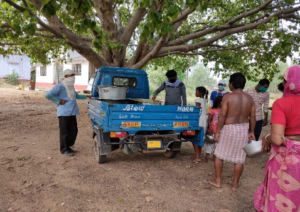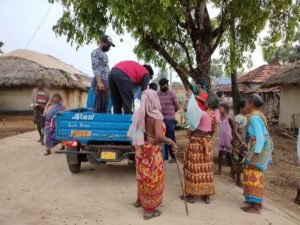Uncommon Response for Common People – The Case of Bankura (West Bengal)
By Sritama Rana and Porag Shome
The humanitarian assistance extended by the Civil Society Organisations (CSOs) to different marginalised communities across the country during the lockdown has been unique (so far) and in several cases has out-performed the State’s response. Be it in terms of organising cooked food, distributing dry rations, connecting the needy with government-supported supply channels or coordinating efforts for the return migration of labourers – such efforts are unheard of in other countries. The support extended is just the start in the long struggle for normalising lives and livelihoods of the marginalised community and will require concerted efforts in the coming days as we start lifting the lockdown in a phased manner.
As we move ahead in this fight, it is befitting to pause and acknowledge the efforts made by several large and small informal1 citizen groups that are unregistered and have no formal access to leverage financial support, and which came together to extend humanitarian support. At the societal level, such ‘coming together’ also reveals the sense of affinity deep in human consciousness, which surfaces and gets articulated through collective actions, especially in the time of emergency.

One such effort worth acknowledging, and applauding is by a small, diverse youth group from a village called Kanchanpur under the Purandarpur panchayat of Bankura (Block -II)2. This self-motivated group started a door-to-door collection drive intending to support the vulnerable and marginalised groups in their village badly hit by the lockdown and left to their fate without any assistance, an unfair PDS and no source of earnings. Initially, the group managed to mobilise some resources (rice, pulses, potatoes) from the relatively well to do families and extended support to 150 families in their village.
Foreseeing the probable impacts due to the extended lockdown along with halted economic activities, sudden closure of employment opportunities, defunct or meagre supply through PDS, this group decided to step up their efforts and reach out to nearby villages as well. A rapid assessment of nearby villages revealed a severe food crisis and struggle for survival. The monthly ration provided through PDS was biased, inadequate and did not meet the actual need. The conditions were frightening and alarming, especially amongst the tribals, beggars, women-headed households, widows with children, and households with senior citizen/s.
Gradually, the support from local elites started weaning and began to be fragmented on political party lines. Assuming the worst, the group started reaching out beyond the circle within their reach. The immediate challenge was the inability to receive fund or donations because of the informal nature of the association. The authors started talking to several active CSOs, the network of CSOs, funders and other student associations/unions. Out of the long list of names, a few responded.

One of the first groups to respond was the Quarantine Student Youth Network (QSYN)3. Indian students’ associations have played a significant role in the relief and rehabilitation phase in the past. In this unplanned lockdown, again it was this students’ network which responded to the distress call from Bankura. The QSYN was running community kitchens (People’s Kitchen) in several locations of West Bengal and providing cooked meals to deprived households. This strategy reduced the overall cost as well as ensured effective resource management and maximum reach. In the following three-four days, QSYN made several enquiries to ascertain the validity of the ‘need’ in the village. The joint effort of the group and QSYN finally started on April 13 with a kitchen providing 300 -350 meals per day to the neediest across 8-10 villages.
The process was an arduous one – be it running the kitchen or maintaining fairness in food distribution or connecting with support agencies and group. At the ground level, identifying the most vulnerable and genuinely needy posed a critical challenge. While nation-wide efforts were being made for migrant communities, it was difficult to process and arrange for the need of the sedentary communities. More difficult was to locate and organise relief for households just above the poverty line. These households were certain of the present crisis and equally uncertain of receiving any relief. The distribution of food continued with hardly any support or encouragement from the community or local political leaders. Instead, the relief measures were pitched on party lines to cause further disruptions in the efforts. Attempts to collaborate with a few other CSOs failed as several of them were uninterested in a collaborative approach. Inter-agency coordination was missing across the massive relief effort. Direct and indirect doubts on the capacity and integrity of the group were questioned at every step by everyone. Most of the time, the local administration was silent. Neither did they interrupt the work, nor responded when approached. Another crucial operational challenge was coordinating work between the volunteers from other villages and QSYN with the restriction on mobility and availability of vehicles.

As we document our experiences, the joint effort with QSYN continues and the group, over time, has successfully reached out to more than ten villages in Bankura-II block and Gangajal Ghati Block covering more than a thousand families. Discussions on the ‘continuation of support’ have already started within the group, which is of utmost importance considering the health safety of the members and the emerging possibility of them having to return to their own jobs once the lockdown is eased.
Acknowledgements: The authors would like to express deep gratitude and thanks to Quarantined Student Youth Network (QSYN), Dr Samir Karmakar (Jadavpur University) and to the Azim Premji University, (Bengaluru) for extending their support and showing their confidence in us to work in solidarity. We would also like to thank the peer- group community members and our loving family members without whom it would not have been possible for us to start with this drive.
AUTHORS
Sritama Rana, alumnus of the Azim Premji University, Bengaluru, completed her MA Dev programme in 2018 and is professionally engaged with Kudumbshree NRO. She is posted as a Field Coordinator in Palamu and Pakur district, Jharkhand. Her academic interest are livelihoods, social enterprise and community-based actions.
Porag Shome is a faculty with Azim Premji University with academic interest in livelihoods of marginalised communities (such as Tribal, DNT, & Women in Prostitution).
Disclaimer: The views and opinions expressed in this article are those of the author/s and do not necessarily reflect the official policy or position of Azim Premji University or Foundation.


Dear Sritama,
Fantastic work. I am sure that with all your experience and livelihood interest you will take this crisis as a turning point in the lives of many.
Congratulations